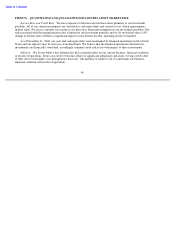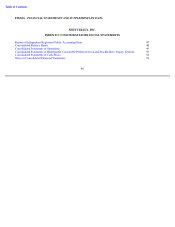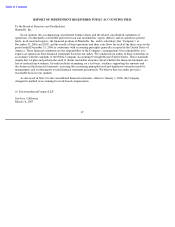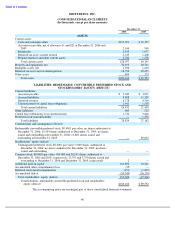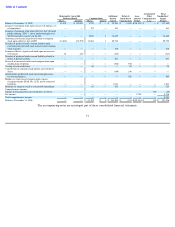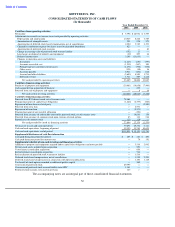Shutterfly 2007 Annual Report Download - page 59
Download and view the complete annual report
Please find page 59 of the 2007 Shutterfly annual report below. You can navigate through the pages in the report by either clicking on the pages listed below, or by using the keyword search tool below to find specific information within the annual report.
Table of Contents
SHUTTERFLY, INC.
NOTES TO CONSOLIDATED FINANCIAL STATEMENTS
(In thousands, except per share amounts) — (Continued)
Fair Value of Financial Instruments
The carrying amount of certain of the Company’s financial instruments, including accounts receivable and
accounts payable, are carried at cost, which approximates their fair value because of their short-term maturities.
Based on borrowing rates available to the Company for loans with similar terms, the carrying value of borrowings,
including capital lease obligations, approximates fair value.
Concentration of Credit Risk
Financial instruments that potentially subject the Company to credit risk consist principally of cash, cash
equivalents and accounts receivable. Most of the Company’s cash and cash equivalents as of December 31, 2006
were deposited with financial institutions in the United States and Company policy restricts the amount of credit
exposure to any one issuer and to any one type of investment. Deposits held with financial institutions may exceed
federally insured limits.
The Company’s accounts receivable are derived primarily from sales to customers located in the United States
who make payments through credit cards. Credit card receivables settle relatively quickly. The Company maintains
allowances for potential credit losses on customer accounts when deemed necessary. To date, such losses have not
been material and have been within management’s expectations. As of December 31, 2006, one customer accounted
for 14% of the Company’s net accounts receivable and as of December 31, 2005, another customer accounted for
18% of the Company’s net accounts receivable.
Inventories
Inventories are stated at the lower of cost on a first-in, first-out basis or net realizable value. The value of
inventories is reduced by estimates for excess and obsolete inventories. The estimate for excess and obsolete
inventories is based upon management’
s review of utilization of inventories in light of projected sales, current market
conditions and market trends. Inventories are primarily raw materials and consist principally of paper, photo book
covers and packaging supplies.
Property and Equipment
Property and equipment, including equipment under capital leases, are stated at historical cost, less accumulated
depreciation and amortization. Depreciation and amortization are computed using the straight-line method over the
estimated lives of the assets, generally three to five years. Amortization of equipment acquired under capital lease
obligations is computed using the straight-line method over the shorter of the remaining lease term or the estimated
useful life of the related assets, generally three to four years. Leasehold improvements are amortized over their
estimated useful lives, or the lease term if shorter, generally three to five years. Upon retirement or sale, the cost and
related accumulated depreciation are removed from the balance sheet and the resulting gain or loss is reflected in
operating expenses. Major additions and improvements are capitalized, while replacements, maintenance and repairs
that do not extend the life of the asset are charged to expense as incurred.
Website Development Costs
The Company capitalizes eligible costs associated with software developed or obtained for internal use in
accordance with AICPA Statement of Position 98-1, Accounting for the Costs of Computer Software Developed or
Obtained for Internal Use , and EITF 00-02, Accounting for Web Site Development Costs. Accordingly, the
Company expenses all costs that relate to the planning and post implementation phases. Costs incurred in the
development phase are capitalized and amortized over the product’s estimated useful life. The Company has
capitalized website development costs incurred in the application development phase and unamortized cost is
included in property and equipment and totaled approximately $2,582 and $2,187 at December 31, 2006 and 2005,
54



